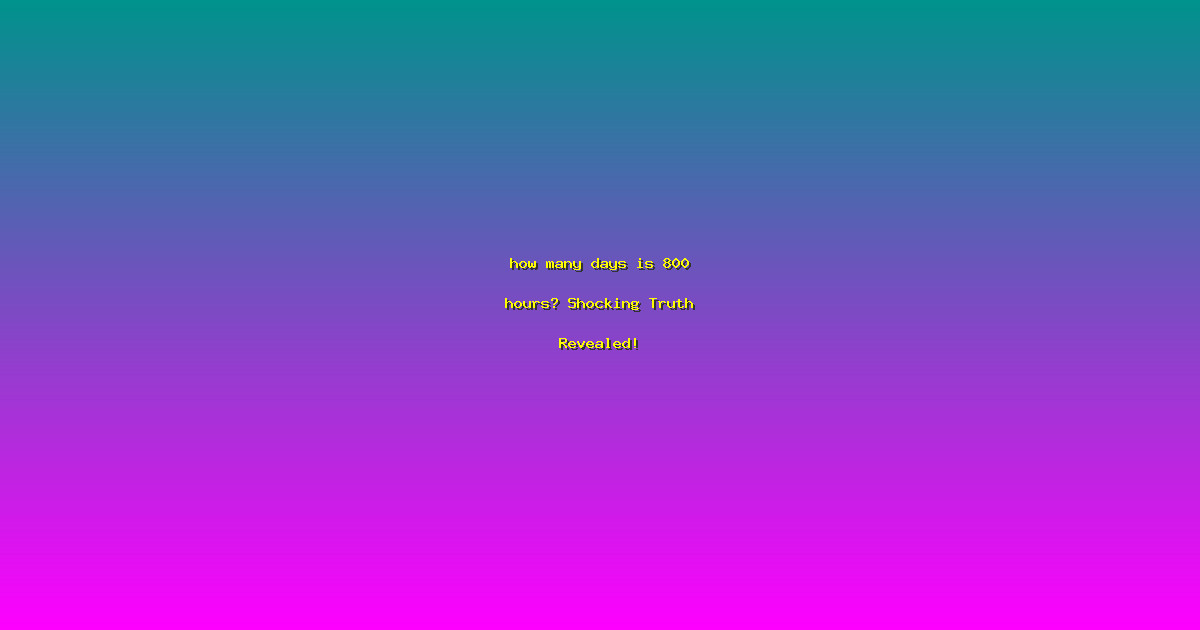how many days is 800 hours? Shocking Truth Revealed!
Have you ever wondered how many days 800 hours actually equates to? This seemingly simple question can have a profound impact on how you manage your time and productivity. Whether you’re planning a project, setting goals, or just curious about the math, understanding the answer can help you make better decisions. In this article, we’ll uncover the surprising truth behind how many days 800 hours is and explore practical ways to use this knowledge to your advantage. Let’s dive in and discover the shocking truth!
Understanding the Basics: How Many Days is 800 Hours?
To start, let’s break down the math. There are 24 hours in a day. So, to find out how many days 800 hours is, we simply divide 800 by 24. The result is approximately 33.33 days. This means that 800 hours is just over a month, or more precisely, 33 days and 8 hours. This might seem straightforward, but the implications of this calculation can be quite significant.
- Key Point: 800 hours is equivalent to 33.33 days.
- Key Point: This calculation is crucial for project management and time tracking.
- Key Point: Understanding this conversion can help in setting realistic goals and deadlines.
Practical Applications of 800 Hours
Knowing that 800 hours is about 33 days can be incredibly useful in various contexts. For instance, if you’re planning a project that requires 800 hours of work, you can estimate that it will take roughly a month to complete. This can help in setting realistic timelines and allocating resources effectively.
- Key Point: Use this knowledge for project management and resource allocation.
- Key Point: According to a study by the Project Management Institute, 70% of projects fail due to poor time management. Understanding the conversion can help avoid such pitfalls.
- Key Point: Implement this knowledge by breaking down tasks into smaller, manageable chunks to ensure timely completion.
Time Management Strategies for 800 Hours
Now that we know 800 hours is about 33 days, let’s explore some strategies to manage this time effectively. Time management is crucial for productivity and success. By breaking down the 800 hours into smaller, manageable segments, you can ensure that you stay on track and meet your goals.
- Key Point: Break down the 800 hours into weekly or daily tasks to maintain focus and momentum.
- Key Point: According to productivity expert Laura Vanderkam, “Time is a fixed resource, but how we use it is up to us.” Use this mindset to make the most of your 800 hours.
- Key Point: Implement time-blocking techniques to allocate specific hours to different tasks, ensuring that you make the most of your time.
Frequently Asked Questions
How can I accurately estimate the time needed for a project?
To estimate the time needed for a project, start by breaking down the project into smaller tasks. Assign a time estimate to each task and then sum them up. This will give you a more accurate picture of the total time required. For example, if a project involves 10 tasks, each taking 80 hours, the total would be 800 hours, or about 33 days.
What are some common mistakes in time management?
Common mistakes include underestimating the time needed for tasks, failing to account for unexpected delays, and not prioritizing tasks effectively. To avoid these pitfalls, use tools like Gantt charts or project management software to keep track of your progress and adjust as needed.
How can I stay motivated over a long-term project?
Staying motivated over a long-term project can be challenging. Break the project into smaller milestones and celebrate each one as you complete it. This can help maintain your motivation and keep you on track. Additionally, set regular check-ins to review your progress and make adjustments as necessary.
Is it better to work in long stretches or shorter intervals?
Research suggests that working in shorter intervals with breaks can be more effective than long stretches. The Pomodoro Technique, for example, involves working for 25 minutes followed by a 5-minute break. This method can help maintain focus and prevent burnout.
How can I apply this knowledge to my daily routine?
To apply this knowledge to your daily routine, start by tracking how you spend your time. Use a time-tracking app or a simple journal to log your activities. Once you have a clear picture of where your time goes, you can make adjustments to optimize your productivity. For example, if you find that you spend 800 hours on a particular task, you can break it down into smaller, more manageable chunks.
Conclusion
Understanding that 800 hours is approximately 33 days can be a game-changer for your productivity and time management. By breaking down large tasks into smaller, manageable segments, you can stay on track and meet your goals. Whether you’re planning a project or managing your daily routine, this knowledge can help you make the most of your time. So, the next time you’re faced with a task that requires 800 hours, you’ll know exactly how to approach it. Start by breaking it down and setting realistic timelines. With these strategies, you can transform your productivity and achieve your goals more efficiently.
